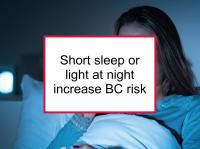Low levels of melatonin due to excess exposure to light or as natural part of the aging process is associated with increased risk of breast cancer. Melatonin is a hormone that communicates information concerning environmental light conditions to various parts of the body and plays a vital role in the synchronization of circadian rhythms.
Melatonin is synthesized and secreted by the pineal gland in the brain. Melatonin has been shown to reduce estrogen production in normal breast cells near malignant cells, as well as to reduce tumor angiogenesis (new blood vessel formation).
Habitually sleeping in the presence of artificial light appears to increase breast cancer risk by inhibiting melatonin production. Women can maintain their melatonin levels by getting enough sleep, avoiding night shift work and light exposure at night, and consuming melatonin-rich foods. Now a new study has confirmed previous reports that light in the bedroom at night is associated with increased risk of breast cancer.
Night shift work and breast cancer among nurses
Nurses engaging in night shift work have higher rates of breast cancer than nurses working day shifts. However some types of schedules appear to be more harmful than others and the number of years of night shift work also makes a difference. A Norwegian study which included 44,835 nurses found no increase in breast cancer risk after long periods during which nurses worked at least three night shifts per month. Small, statistically insignificant increases in risk were found for exposure to working at least 12 years in schedules that included some night work, working a total of at least 1,007 night shifts during one's lifetime, or having a lifetime average number of at least four night shifts per month.
Higher, but still statistically insignificant increases in risk of breast cancer were found in women who worked at least five years with at least four consecutive night shifts or at least five consecutive night shifts. However, significantly increased risks were observed in nurses who worked at least five years with six or more consecutive night shifts. Hence, the increase in breast cancer risk appears to be related to number of consecutive night shifts and the number of years of such shifts worked.
Latest research finds light at night is associated with increased risk
The study referenced at the beginning of this news story was designed to investigate the association between sleep habits, including light at night, and risk of breast cancer. The study included 93 breast cancer patients and 185 matched controls during the period 2010 to 2014. The authors used a questionnaire to collect data concerning sleeping habitat in the five-year, 10-year and 15 year-year period before diagnosis. Included were questions concerning quality of sleep, bedtime, hours of sleep, TV watching habits, reading before sleeping, intensity of light in the bedroom, and type of illumination.
Long duration of sleep during the period 10 to 15 years before diagnosis was found to be associated with reduced breast cancer risk. Women who had been exposed to modest levels of artificial light at night from reading using a reading lamp women and women who had slept with closed shutters had reduced breast cancer risk compared to those exposed to more light. Women who had been exposed to artificial light at night as a result of living near strong light sources were found to be at significantly higher breast cancer risk.
The authors conclude that the results support the hypothesis that reducing night time light exposure could reduce breast cancer risk, a hypothesis that needs to be tested using technology that continuously measures a person’s light exposure and sleep length.
